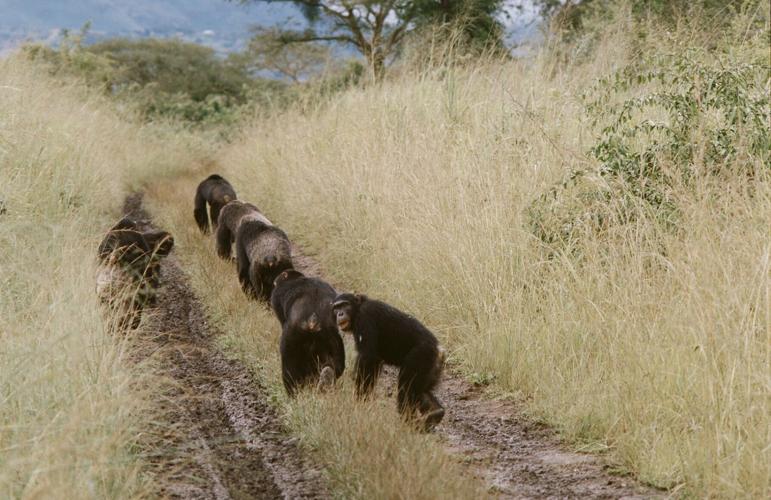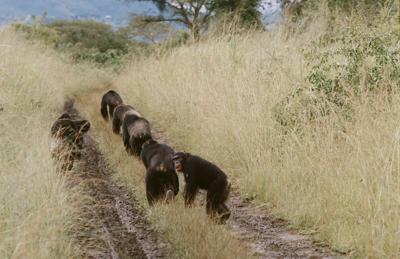We hear the chimpanzees long before we see them. Ear-piercing hoots and shrieks cut through the forest understory like a machete, as our group ā eight tourists, two guides and three porters ā descends a steep, muddy trail, stamped with hippo footprints, into Kyambura Gorge.
The small rift valley in western is home to an isolated community of habituated chimpanzees, and before our arrival, trackers had searched out one of its 10 chimp families. (Habituated chimps have become accustomed to seeing humans through repeated exposure, which is crucial for safe ape tourism and conservation.)
Hiking to see chimps is the countryās second most popular tourism activity after gorilla trekking, and this lush rainforest, sunk 100 metres below the savannah of , is one of the best places to see them.

A chimp spotted with Volcanoes Safaris. The company pioneered primate trekking in Uganda and Rwanda 25 years ago.
Volcanoes SafarisAlmost immediately we spot movement in the treetops, and we mask up to protect the apes from communicable diseases like influenza, which can be fatal to them. For our own safety, weāve been briefed not to mimic their calls, or consume food or drink in front of them.
āWe always recommend when they are coming close, to take a step away,ā cautions Judith Nyamihanda, a guide with the Uganda Wildlife Authority. āWhen you hear that strong vocalization, donāt get scared. Stay calm.ā
Soon, screeches echo through the gorge as a young male displays his strength by running, swinging around limber branches and drumming forcefully on mossy buttresses.

On ape treks, travellers must mask up to prevent spreading disease to the vulnerable animals, explains the writer (pictured).
Courtesy of Lisa KadaneRather than feeling trepidation, Iām filled with awe, watching his eerily human bravado. The feeling of kinship continues as I observe the alpha chimp holding a staff like a king before drinking water from the Kyambura River and, later, see a baby practice its tree-climbing skills while a suitor grooms Mom ā all while a bloat of hippos snorts from a shallow pool in the narrow river.
The opportunity to spend a magical hour watching our closest ape relatives go about their daily business is one reason this landlocked East African nation is attracting more travellers. Uganda welcomed 1.2 million international visitors in 2023, up 56 per cent from the previous year.
Dubbed the Pearl of Africa by Winston Churchill for its lush beauty and diversity of landscapes and wildlife, itās a place where you can view classic game, such as elephants, lions, leopards and Cape buffalo, in its 10 national parks, or see the source of the Nile River on Lake Victoria.

Great apes arenāt the only creatures you can see inĀ Uganda: wildlife seen by the writer on the Kazinga Channel.
Lisa KadaneWhat sets Uganda apart from its neighbours Kenya and TanzaniaĀ is its Great Ape Circuit, offered by tour companies in the region. Itās an unofficial wildlife route through parks that offer the chance to see and spend time with chimpanzees and gorillas, on foot, in a responsible and sustainable way.
These great ape treks limit visitor numbers and come with heavy restrictions and a high price tag, in order to safeguard the animals and their environment. Tourists must wear masks, maintain a safe distance (where possible), and pay upwards of $800 (U.S.) for the privilege of spending an hour with gorillas. (Chimp trekking permits cost less, between $80 and $250 for an hour with the animals. All ape permit numbers are limited and vary by location.)
Iām travelling with , the company that pioneered primate trekking in Uganda and Rwanda 25 years ago. Our stops on this seven-day safari include , the primate capital of the world; there are 13 species here, including some 1,500 chimpanzees and eight kinds of monkeys. We also visit Queen Elizabeth National Park, home to four of the Big Five (everything except rhinos), and , famous for its endangered mountain gorillas.

InsideĀ Volcanoes Safarisā recently opened Kibale Lodge.
Shaun S. Ritchie / Volcanoes SafarisBetween adventures, we stay at the companyās safari lodges, which are as much a part of the experience as the wildlife encounters. Though luxurious, the lodges are rooted in community; they incorporate local art and traditional foods, and 85 per cent of staff hail from neighbouring towns. Guests also have opportunities to participate in programs supported by the non-profit Volcanoes Safaris Partnership Trust (VSPT), which connects the properties to surrounding towns and conservation programs.Ā
At , for example, we plant trees in the gorge buffer zone, a tract of land purchased by the VSPT to create a cushion between the chimpsā habitat and the community. Itās seeded with non-fruiting indigenous trees, as well as arabica and robusta coffee plants that arenāt tasty to chimps, so they donāt venture through the buffer onto local farms looking for food. Human-wildlife conflicts are one of the apesā main conservation challenges.
Women in the Kyambura Womenās Coffee Cooperative harvest, process and sell the coffee back to Volcanoes Safarisā lodges to serve to guests. The locals earn a fair, sustainable wage and become invested in the apesā protection. Itās a message we hear everywhere in Uganda: When communities benefit from tourism, they protect the wildlife and habitat.

Kibale Lodge, Volcanoes Safarisā new lodge for chimp safaris, overlooks the Rwenzori Mountains and the Queen Elizabeth plains.
Volcanoes SafarisWhile tourism in the country is growing, it will remain small-scale, says Volcanoes Safaris founder Praveen Moman, who grew up in Uganda. āThatās sort of its charm. Thereās enough to see, but itās not teeming with millions of people,ā says Moman. āAnd the primate experience is, by definition, limited. It becomes very intimate and special.ā
Itās that intimacy with the apes that grips my heart ā and gives me goosebumps. On our final day, in Bwindi Impenetrable Forest, our small group follows a staircase of forest elephant footprints into the apesā secret garden, a misty jungle fastness where steep, narrow trails form a natural barrier to entry.
Although our guide with the Uganda Wildlife Authority, Gloria Asasira, has briefed us on what to expect, Iām utterly unprepared. After almost two hours of hiking, weāre suddenly surrounded by a family of 17 habituated gorillas, including a mom cradling a baby. The silverbackās pungent odour announces his presence before I see his muscular body emerge from the woods. He grunts softly, a vocalization that Asasira says lets his family know itās OK ā weāre like visiting kin.

Some of the habituated gorillas encountered during the writerās hike, including the baby that stole everyoneās heart.
Lisa KadaneāThey are our cousins because we share their DNA at 98.4 per cent,ā says Asasira. āThey always mind their own business. If they are feeding, they will not stop feeding. If they are playing, they will not stop playing.ā
And if youāre crouched on the path, like me, taking pictures, they will walk right past you, brushing your sleeved arm with their bristly, furry one.
Led by the silverback, the gorillas move quietly up the trail and into the bush, stuffing their faces with leaves as they go, the little ones hitching rides. We track them into a tea field, then higher into dense bush, with vertigo-inducing views of green hills, quilted with farmersā fields below.
When our short hour is over, the gorillas are gone, as if on cue. They left quietlyĀ as suddenly as the noisy chimps of Kyambura Gorge arrived. But thatās Uganda ā understated yet simultaneously in-your-face, a destination that leaves you wanting more.
Lisa Kadane travelled as a guest of Volcanoes Safaris, which did not review or approve this article.







































To join the conversation set a first and last name in your user profile.
Sign in or register for free to join the Conversation